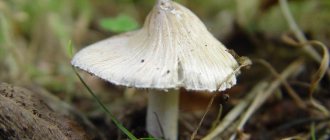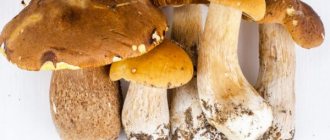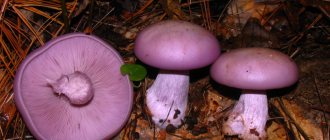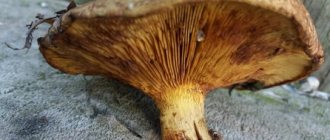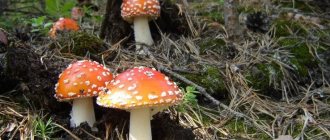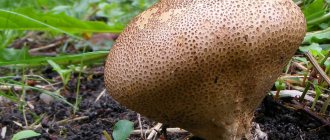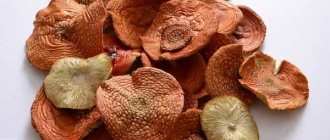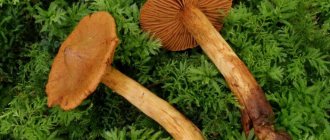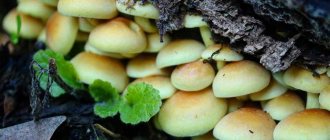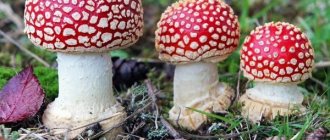When collecting mushrooms, it is extremely important not to confuse edible with poisonous ones. Otherwise, this can lead, at best, to disruption of the functioning of the body, and at worst, to death. The pointed row is a dangerous mushroom; it is extremely necessary to distinguish it from other fruits. If there is the slightest doubt, it is better not to put the fruiting body in the basket.
Description
The pointed row is similar to many representatives of its genus, but differs in its conical cap.
The row is pointed.
hat
Shape: in young specimens the cap has the shape of a bell with a cone-shaped outgrowth in the center; in adulthood, the cone turns into a small “hump” on the convex surface of the cap.
Size: the pointed row has a small cap, reaching 8 cm in diameter in adulthood.
- The cap of the pointed row is gray with an ashen tint, darker towards the center, the edges may be striped.
- Shiny, slightly fibrous, leathery.
Leg
Mouse row.
Shape: cylindrical with slight expansion downwards.
Size: the pointed row leg is long and not wide (approximately 15 * 1.5 cm in length and in diameter, respectively).
Color: the main color is white, towards the base it has a color from yellowish to pinkish.
Surface: smooth.
Spore-bearing layer
The row is striped.
Type: lamellar.
Color: white to gray, covered with yellowish spots when mature.
Features: they can be either attached or free, they are often located, and have uneven edges.
Pulp
The row is searingly sharp.
Density: Fairly hard.
color .
Organoleptic features: odorless, but has an extremely pungent taste. The intensity of pungency varies (may be more or less pronounced in different specimens).
Spore powder
Spores: ovoid, medium-sized, 4 pieces per basidia.
Spore powder: mostly white.
Medicinal properties and contraindications
Pine horns are endowed with many healing qualities and are used in folk medicine. They contain a large amount of folic acid, potassium, magnesium, ergothioneine, lecithin, polysaccharides, protein, natural antibiotics (fomecin, clitocin), vitamins of various groups.
Spotted row reduces the amount of cholesterol in the blood, strengthens the immune system, prevents diabetes, and has a powerful antioxidant effect. It copes with hypertension, viral diseases, and is recommended for use in diseases of the joints, genitourinary system, infertility, gastric ulcers, and atherosclerosis. Used for various external problems - wounds, bites, bedsores.
The mushroom is also capable of defeating more serious ailments: it is used in complex therapy for malignant tumors, in the last stages of cancer. Pine row has proven itself well as a natural cosmetic product. Its extract improves the appearance of the skin, brightens it, and eliminates unwanted pigmentation. The drug reduces the activity of tyrosinase, which synthesizes melanin, without causing side effects.
In matsutake per 100 g – 28 kcal:
- proteins – 3.9 g;
- fat – 0.7 g;
- carbohydrates – 1 g;
- dietary fiber – 1.2 g;
- ash – 0.8 g;
- water – 89.5 g.
It also contains glucose (0.2 g) and fructose (1.5 g) per 100 g.
In its chemical composition, the exotic mushroom is close to meat, which makes it a product indicated for consumption by vegetarians. Its low fat content allows those who are on a diet to regulate their weight without harm to health.
There are no special contraindications for the shod row. It is only possible that it may be poisoned during long-term storage or that there may be individual intolerance to its components. In the latter case, you should not eat the mushroom.
Tincture with vodka or alcohol: indications for use
Matsutake tincture is taken to treat malignant diseases and tumors.
Recipe 1
Components:
- vodka – 500 ml;
- Japanese truffles – 5 kg.
Preparation:
- Clean the raw materials from dirt and rinse.
- Place in a glass container and fill with vodka.
- Leave for 2 weeks in a place protected from direct sunlight.
The infusion can be used externally and orally:
- Soak a piece of gauze folded in four or more in the solution. Place it on the problem area and remove it after 30 minutes.
- Internal reception is carried out using the “slide” method. The first time you need to drink one drop. The next day another one is added to it. The total number is brought to 25. Then the dose is reduced in the reverse order.
Recipe 2 (for external use)
Components:
- spotted rows - 100 g;
- Vaseline or rendered lard – 200 g
How to prepare:
- Chop the mushrooms and combine with the base.
- Place in a cool place for 10 days.
- After this, you can lubricate the sore spots with it at night. In the morning, cleanse the skin of residues.
How to use for oncology
In the Land of the Rising Sun, the shod row is considered the best anti-cancer remedy and is used for blood diseases. And the healers of the Celestial Empire are convinced that the fruits have the greatest healing power within 48 hours after collection; it is during this period that they have the maximum effect on leukemia. Moreover, young, full-fledged specimens are used. The mushroom should be eaten raw, cut into thin slices. Or dry it at a temperature not exceeding 50 ºС, then it will retain all its healing properties.
Mature mushrooms, the cap of which has opened, no longer have such power and are used as a preventive anticancer agent that cleanses the body of radionuclides and carcinogens.
Similar species
The external similarity of the pointed row is observed with the following types of mushrooms:
- The row is silver.
Conditionally edible. It is distinguished by the presence of dark scales on the surface of the cap. The taste of this mushroom is not bitter, but mealy.
- The row is gray.
Edible. It differs in that the growth in the center of the cap is not conical, but flatter, and the surface of the cap often cracks.
1-Row silver. 2-Row gray.
- The row is soapy.
Inedible. It is distinguished by the uniform color of the cap, as well as the intense smell of laundry soap.
- The row is different.
Conditionally edible. It also smells unpleasant, the leg is colored greenish or yellowish.
- The row is earthy.
Edible. The color of the cap has a brownish tint. There are remains of velum on the edges of the cap (in young specimens).
1-Row soap. 2-The row is different. 3-Row is earthy.
As can be seen from the above, the pointed row has a number of “doubles”, among which there are also edible specimens. Therefore, when collecting edible rows, it is important not to confuse them with pointed rows.
Where does the pointed row (mouse) grow?
You can find a pointed row in deciduous or coniferous forests. Also, the mushroom does not ignore mixed plantings. The ideal symbiont trees for the species are larches, spruces, and pines. Therefore, the formation of mycorrhiza successfully occurs in the climatic conditions of Europe and North America. On the territory of Russia, the species grows in the Caucasus, Crimea, Krasnodar Territory and regions of the middle zone. Mushrooms like acidic, moist soil that is not too fertile. They grow in rows or groups. The fruiting period lasts throughout the autumn - from the beginning of September until the onset of frost.
Interesting Facts
Tricholoma virgatum.
If you accidentally consume a pointed row (for example, when it gets into a dish along with edible mushrooms), after about 40 minutes (if a significant amount of row is eaten) or from 2 to 5 hours (if a small amount of this mushroom gets into the food), the following symptoms occur:
- Nausea.
- Vomit.
- Pain in the stomach.
- Diarrhea.
- Fall in blood pressure.
- Heart rhythm disturbance.
Due to the disruption of the cardiovascular system, poisoning with acuminate grass can even lead to death. At the first symptoms, you need to rinse your stomach and immediately call an ambulance.
Cooking recipes
If you are going to cook a delicious dish from the row, then keep in mind: the mushroom boils down a lot. For example, to make pickles, the talker needs to be boiled, so from 1 kg of collected mushrooms you will get only 1 liter jar.
Primary processing
Before cooking, the fruits should be cleared of forest debris with a knife and washed. The row requires pre-cooking for 15-20 minutes.
Cooking
You need to cook talkers before marinating and salting. You can use boiled mushrooms as a separate dish.
Ingredients:
- 1 kg of gray row;
- 1 liter of water for cooking;
- 1 tbsp. l. salt;
- 0.25 tsp citric acid;
- 5 black peppercorns;
- 1 bay leaf;
- 2 pcs. carnations.
How to cook:
- Clean the collected rows from forest dirt with a knife. Remove damage and darkened areas from the fruit. You can peel off the top layer of the cap.
- Wash the mushrooms thoroughly under running water.
- Pour cold water into an enamel pan, add salt and citric acid. Bring the marinade to a boil.
- Place a row in the pan and close the lid. Time it for 10 minutes.
- Add black pepper, bay leaf, cloves. Cook for another 10 minutes.
- Drain the water and cool. If you plan to serve the rows on the table and do not plan further processing, supplement the dish with sour cream and finely chopped fresh herbs.
Pickling
To prepare this type of preservation you will need the following ingredients:
- 1 kg of rows;
- 2 tbsp. l. 9% vinegar;
- 1.5 tbsp. l. Sahara;
- 10 pieces. peppercorns;
- 1 tbsp. l. salt;
- 2 bay leaves;
- 4 clove inflorescences.
Step-by-step preparation:
- Sort the fruits and wash them. Large mushrooms are cut into slices, small ones can be left as is.
- Place the rows in a saucepan, fill with water. Cook until they sink to the bottom (at least 20 minutes). Foam will form during the cooking process. Remove it with a slotted spoon so as not to spoil the marinade.
- Add vinegar and turn off heat.
- Pour the contents of the pan into sterilized jars and seal.
- Turn the containers upside down and wait until they cool completely. The pickled mushroom is placed in the cellar and enjoyed with pickling all winter.
Freezing
Before freezing the rows, they must be thoroughly cleaned and boiled. The process consists of the following stages:
- Boil the washed and peeled rows (see recipe above).
- Place the fruits in a colander, let them drain, and then dry them on a napkin or towel.
- When the rows have cooled and dried, place them in a plastic container or plastic bag.
- Store the preparation in the freezer.
Frying
You can add a special mushroom taste and aroma to your favorite fried potatoes or other side dishes using the following dish.
Products:
- 500 g mushrooms;
- 2 liters of water;
- 2 tbsp. l. sunflower oil;
- 1 tbsp. l. salt.
Preparation:
- It is necessary to clean the row of dirt. Cut off the edges of the stem and wash the talkers.
- Place the mushrooms in a saucepan and cover with water. Add some salt.
- Cook the rows for 20 minutes, periodically removing the foam.
- Drain the mushrooms in a colander.
- Heat oil in a frying pan. Put talkers in it. Fry for 10 minutes over medium heat, stirring.
- Lightly salt the mushrooms, fry for another two minutes and turn off the gas.
Pickling
It is best to pickle talkers in the fall, because autumn fruiting bodies are denser. Opt for small young mushrooms. The smaller the row, the faster you can salt them and use them for food.
Ingredients:
- 1 kg of mushrooms;
- 2.5 liters of water;
- 75 g salt;
- 3 bay leaves;
- 10 pieces. black and allspice peas;
- 5 pieces. carnations.
How to pickle mushrooms:
- Pour water into a saucepan and place on fire. Add all the above spices and bring to a boil.
- Clean the talkers, wash them. Send into rushing water.
- Reduce heat. Cover the pan tightly with a lid and boil the fruits for 50 minutes.
- Place boiled mushrooms in pre-sterilized jars, add brine from the pan.
- When the jars have cooled, cover them with plastic lids and place them in a cool place.
- The rows can be eaten 35-40 days after salting. Properly salted mushrooms retain their elastic structure and are crunchy.
How to distinguish a poisonous mushroom
We distinguish mushrooms by the skirt on the leg
So, here is a list of the main signs of inedibility.
- In most cases, there is a pungent odor, sometimes mixed with bitterness or rot.
- The leg is almost always thinner, pubescent or with a small “skirt”.
- The edges of the cap quickly begin to curl upward; when broken, droplets of viscous liquid are released and the color changes.
- Adult real (edible) mushrooms like to be tasted by the larvae of weevil mosquitoes or fruit flies; snails and insects are nearby, but they avoid inedible species. Of the edible varieties, only large chanterelles are not worm-free, due to the presence of quinomannose in the fruiting body.
Some species of poisonous rowers may have an odor similar to that of edible species of the genus. Therefore, when collecting, it is important to pay special attention to the external signs of the mushroom. If you are a novice mushroom picker, it is better to go into the forest together with an experienced mushroom picker who will help you immediately, on the spot, solve the problem of “take it or leave it.”
When hiking in the forest completely alone, if you have never collected rows, it is better to abandon them altogether.
